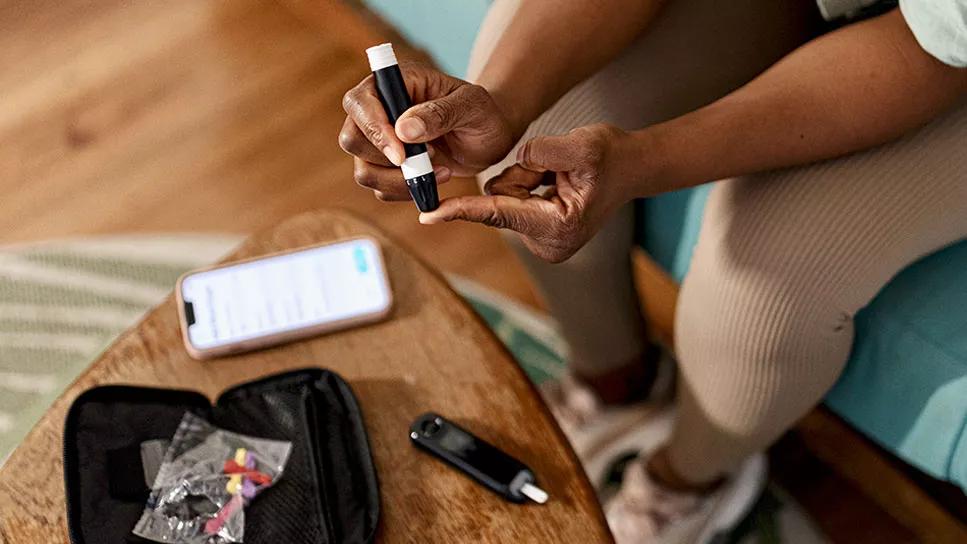New study explores intensification inertia in patients with diabetes and above-goal A1C levels

By Kevin Pantalone, DO, ECNU, FACE
Advertisement
Cleveland Clinic is a non-profit academic medical center. Advertising on our site helps support our mission. We do not endorse non-Cleveland Clinic products or services. Policy
We recently published an article describing intensification inertia in Diabetic Medicine. Therapeutic inertia is very common in clinical practice. A large part of therapeutic inertia has been described as ‘clinical inertia,’ which is defined as the failure to intensify therapy when it appears to be indicated. One example would be if pharmacologic treatment was not intensified in a patient with type 2 diabetes (T2D) and an above-target an A1C level.
We hypothesized that another form of therapeutic inertia exists that has not received much attention. We call this ‘intensification inertia,’ which is selecting a form of intensification that has very little chance of achieving the desired outcome. Whereas doing nothing would be deemed ‘clinical inertia,’ intensifying a treatment with a medication that is not likely to work would be ‘intensification inertia.’
An example would be a patient on two oral anti-hyperglycemic drugs (OADs) and 50 units of insulin glargine with an A1C of 9%. If the insulin dose is increased to 60 units, there is essentially zero chance that will improve the patient’s A1C by 2%, to help them achieve the goal A1C of <7%. Another example would be a patient on full-dose metformin, and glipizide 10 mg daily with an A1C of 9%. Doubling the dose of glipizide to 10 mg twice daily also has a very small chance of getting the A1C to goal. When these interventions are chosen despite their inadequacy, this is what we consider ‘intensification inertia.’
These chosen interventions are unlikely to lower an A1C by 2%. Yet, these interventions are often undertaken in clinical practice for a variety of reasons, including the following:
Advertisement
In our study, we analyzed the electronic health records of 7,389 patients with T2D and stable regimens of two OADs for six months and an index A1C value of ≥7%. Of these patients, 4,647 (62.9%) received no intensification of pharmacologic therapy, or change in pharmacologic therapy.
For those whose therapy was intensified, there were four different intensification methods we considered for the analysis: increasing an existing OAD dose, adding another OAD, adding insulin, or adding a GLP-1 receptor agonist.
Overall, in the 12 months after the index A1C levels were established, there were similarly low probabilities of goal attainment across the entire study population. We anticipated that more aggressive forms of intensification (the addition of new therapies, and injectable therapies in particular) would be more likely to improve A1C goal attainment, but the success of interventions varied by the baseline A1C category. Numerical, but not statistically significant, differences in A1C attainment probability by type of intensification were most marked in people with the highest index A1C (≥9.0%). In this group, injectable therapy showed trends toward greater glycemic control benefits.
Contrary to our expectations, some patients for whom treatment was not intensified actually saw improved glycemic control, perhaps as a result of changes to diet, weight loss, diabetes-related education, or increased compliance with existing therapies. This serves as a good reminder that there are numerous non-medication forms of intensification, such as referrals to nutrition and diabetes educators, which may also improve A1C. However, those were not investigated in this report. We also note that our reliance solely on data from electronic health records for this investigation means that it is impossible to determine patient adherence to medication regimens.
Advertisement
The results of our report are hypothesis generating. The study is retrospective and thus has inherent limitations. Nonetheless, we felt our report was valuable, despite its limitations, because there did not appear to be any research on this phenomenon of ‘intensification inertia.’
This research attempts to define therapeutic inertia and identify additional barriers to successful treatment. The American Diabetes Association recently held a summit on therapeutic inertia, inviting all players that participate in the healthcare system (insurers, healthcare organizations, clinicians, electronic health record systems developers, pharmaceutical industry, etc.) to join forces and try to identify solutions.
In order to develop solutions, the problem has to be clearly defined. We feel that intensification inertia is an important issue in addressing therapeutic inertia. Many times clinicians do attempt to intensify therapy, but our research suggests that the actual choice of therapy/intervention is important, and will influence the likelihood of A1C goal attainment. Intensification inertia is separate from clinical inertia per se, and thus must be acknowledged and addressed as a part of the larger battle of reducing therapeutic inertia.
Advertisement
Advertisement

Patients spent less time in the hospital and no tumors were missed

A new study shows that an AI-enabled bundled system of sensors and coaching reduced A1C with fewer medications

A weight-management program plus anti-obesity medication performs well

TRANSITION-T2D RCT results for patients with T2D receiving MDI

Incidence, outcomes and management

Cleveland Clinic endocrinologists work to identify protocols for improving care

Cleveland Clinic’s Endocrinology & Metabolism Institute is working to offer novel opportunities and therapies for diabetes and kidney disease

New findings indicate the importance of achieving sufficient sleep levels in regard to personal glucose targets